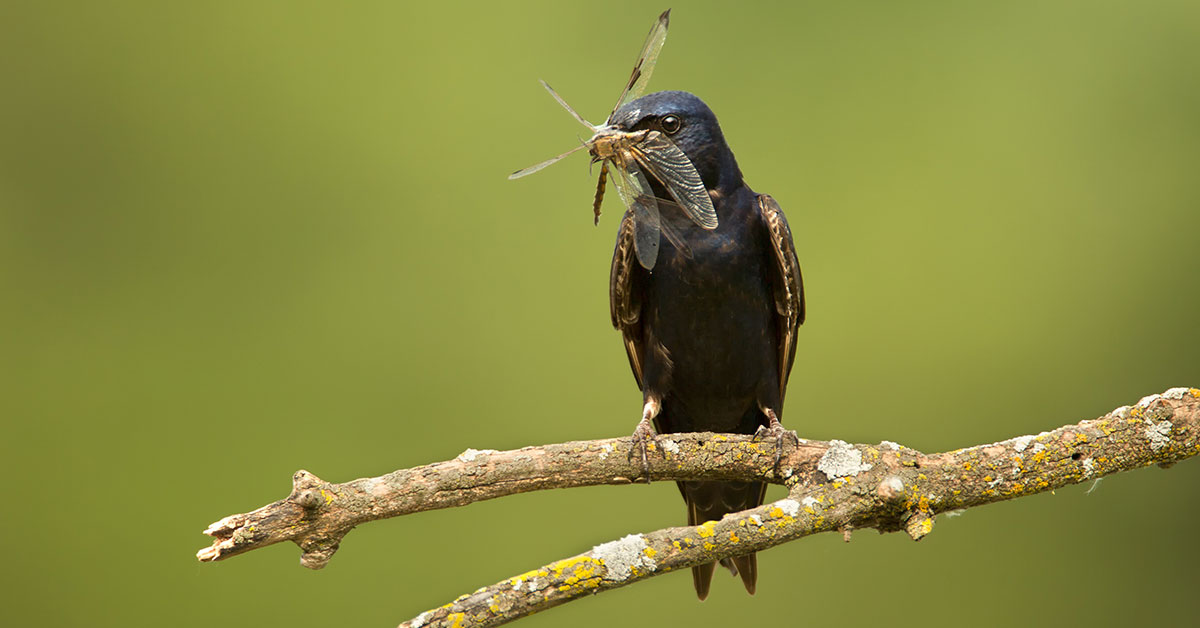Purple martins are a beloved species of bird across the United States. They are beautiful carnivores with metallic blue-purple heads and bodies. They are truly amazing to watch feed as they loop and dive around the garden to feast. Purple martins are also incredibly beneficial for gardeners and backyard enthusiasts. A lot of time and effort has been put into figuring out how to attract purple Martins for good reason. These birds feed on various insects and can help keep your garden and yard clean of pests. To encourage these birds to come to your yard, there are a few steps you can take.
How to Attract Purple Martins
These cuties have an incredibly beneficial impact on the ecosystems they grace. Purple Martins will eat just about any insect and a lot of them. Like any animal, they have preferences for where they live and how they decide.
Purple Martin Migration Pattern
The Purple Martin is a type of swallow that breeds in North America and migrates to South America for the winter months. In the USA, they breed from the Gulf of Mexico to Canada, but primarily in the eastern and midwestern states. The migration typically begins in late summer, with the birds leaving the northern parts of the USA first, followed by the southern states. The migration then continues southward, with the birds making stops in Florida, the Caribbean, and Central and South America. The birds return to the USA in spring, with the younger birds arriving 4-12 weeks before the adults.
Purple Martin Housing
Offering Purple Matins a safe place to stay is a great way to see more of them. Native Americans used to make homes for Purple Martins out of hollowed-out gourds. As such, some people still hold to using natural or man-made gourds, but it isn’t necessary. A nest box is a birdhouse with a single compartment. Thick plastic, Aluminum, sturdy wood, and natural gourds can all be used to construct their summer homes. They settled primarily in mad made or erected structures so providing a variety of designs is good to ensure discerning families have something to pick from.
Purple martins are colonial nesters so they prefer their houses to be clustered together. Purple martin housing should be 50 to 150 feet away from man-made structures and trees. They don’t trust any dense foliage that could hide predators, So as open a space as you can find will work. They also typically feed anywhere from a half mile to 2 miles away from their nests to avoid predators. Placing a network of poles to rest on above and below the nests is a great feature to have. This makes it easier for them to perch on to socialize, keep watch and clean themselves.
Make sure to clean out the birdhouses after the purple martins have left. Leaving a few small piles of twigs and leaves out in the open. This can help to entice them to pick your housing as it will be easy to build their nests.
They will be attracted to housing that is white or light colored, as it reflects the heat and keeps the nest cool. Housing should be 10-20 feet high on top of poles. As other birds will try and take over this housing, sometimes killing the purple martins, we suggest making the nests removable. This way you can put them out around the time you know they are coming. This will stop local birds from taking up residence in them. We cover more about their predators in the next section.
Protect Purple Martins From Predators
Purple martins are very prone to predators in the air and ground. Specifically, house sparrows and European starlings are very aggressive toward them and will kill purple martins to command their nests. Local birds like hawks and owls will also pose a very active threat to purple martins and their nests. Snakes, raccoons, and cats are also active predators of purple martins. If allowed they will climb into a nest and eat whatever they can. Best to keep your cats inside if possible.
Use baffles on the poles holding the structure up to deter land predators from gaining access. Make sure to have perches below and above the structures so the purple swallows can keep a better eye out for threats. Be sure to not put out the purple swallow houses too early, and to take them down after they have left. If you leave them out all year for instance then you will find them invaded by other birds that won’t want to give up their homes or feeding grounds.
Provide A Food Source For Purple Martins
Purple martins are exclusively carnivores that feed on insects. They will eat just about any insects including but not limited to moths, wasps, flying ants, termites, and dragonflies. A popular adage, ‘Purple martins can eat 2,000 mosquitoes a day’, has fallen under scrutiny in recent years. While technically true, their appetites are enormous, they don’t eat many mosquitoes. They tend to eat at a higher elevation than mosquitos prefer.
To ensure a sufficient buffet for your flying friends, use fewer pesticides and more ecologically friendly options. This will ensure that the insect ecology is more diverse and more enticing to the purple martins looking for a home.
Purple Martin Water Preferences
Purple martins do bathe and drink in flight, which is to say that they will not land in a bird bath to clean themselves or drink. They prefer long, natural bodies of water within a half mile to 1 mile of their nest. They will not make use of bird baths at all. They prefer to drink by flying low on water and scooping up a drink. They bathe similarly. Consider if you are near a stream, a large, long pond or lake, a river, a golf course water feature, a drainage ditch, or something analogous.













